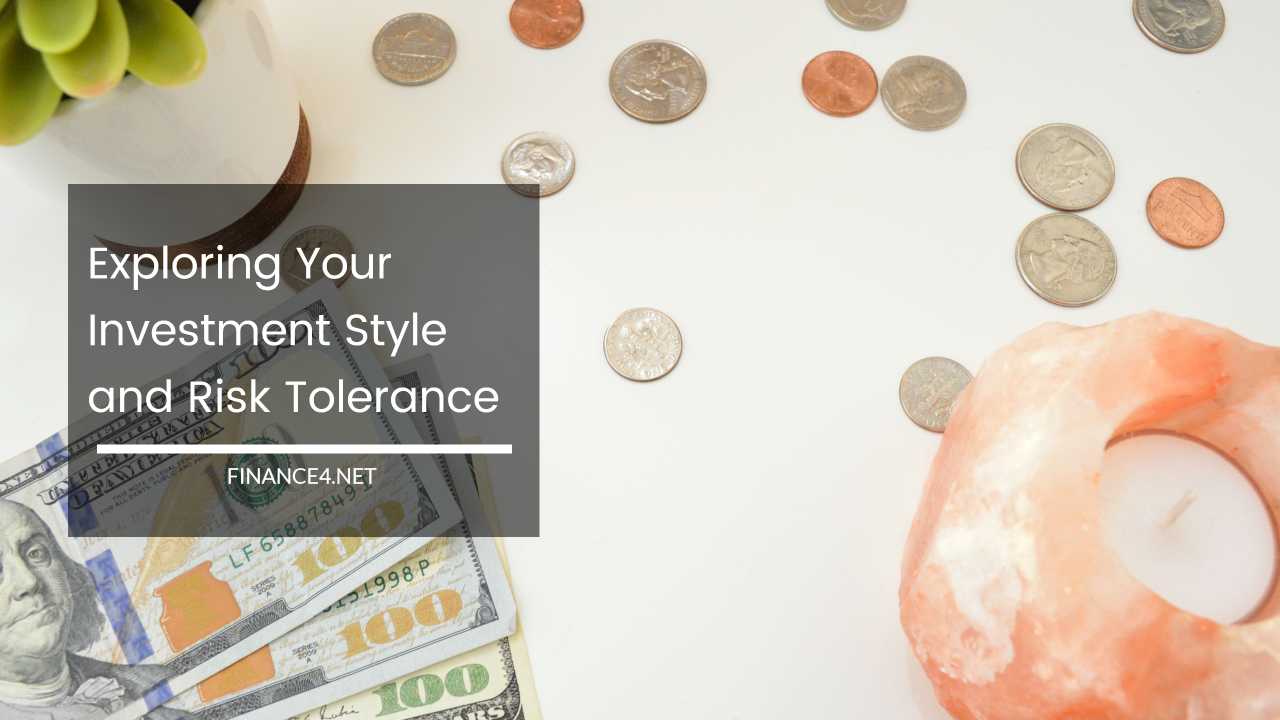Exploring Your Investment Style and Risk Tolerance

Investment Style and Risk Tolerance
Understanding Your Investment Style
Investing is a financial strategy that involves putting your money into various assets with the goal of generating returns over time.
Your investment style plays a pivotal role in determining the types of assets you invest in and the level of risk you’re willing to take.
A crucial factor that influences your investment style is your risk tolerance. By understanding your risk tolerance and investment style, you can make more informed investment decisions that align with your financial goals and comfort level.
In this comprehensive guide, we will delve deeper into the concept of investment styles, explore the three primary investment styles – conservative, moderate, and aggressive, and discuss how these styles relate to your risk tolerance and financial objectives.
What Is Investment Style?
Investment style refers to the approach or strategy an investor adopts when making investment decisions. It encompasses various factors, including the types of assets chosen, the degree of risk undertaken, and the time horizon for investment.
Your investment style reflects your financial personality and goals, and it serves as a guiding framework for building and managing your investment portfolio.
The Relationship Between Investment Style and Risk Tolerance
One of the fundamental principles of investing is that risk and reward are inherently linked. In other words, the level of risk you’re willing to accept will directly impact the potential returns on your investments.
Consequently, your investment style is closely tied to your risk tolerance. Let’s take a closer look at how these two factors interrelate:
- Conservative Investor:
- Risk Tolerance: Conservative investors have a low tolerance for risk. They are more concerned with preserving their initial investment capital than pursuing high returns. As a result, they prefer investment options that are relatively stable and less volatile.
- Investment Style: A conservative investment style focuses on minimizing risk. Conservative investors often allocate a significant portion of their portfolio to low-risk, income-generating assets. Common choices include high-quality bonds, dividend-paying stocks, money market accounts, and savings accounts.
- Moderate Investor:
- Risk Tolerance: Moderate investors have a moderate tolerance for risk. They are willing to accept some level of risk in pursuit of higher returns, but they also seek to protect their capital to a certain extent.
- Investment Style: A moderate investment style combines elements of both conservative and aggressive approaches. Moderate investors typically allocate a portion of their portfolio to safe or conservative investments for stability and income, while also investing in riskier assets like growth stocks, real estate, and diversified mutual funds.
- Aggressive Investor:
- Risk Tolerance: Aggressive investors have a high tolerance for risk. They are willing to take on substantial risk in exchange for the potential of achieving significant returns. Capital preservation is a secondary concern for aggressive investors.
- Investment Style: An aggressive investment style is characterized by a willingness to invest in high-risk, high-reward assets. Aggressive investors often allocate a substantial portion, if not the majority, of their portfolio to equities, including individual stocks and aggressive growth funds. They may also explore alternative investments and venture into more speculative opportunities.
Matching Investment Styles to Financial Goals
In addition to risk tolerance, your financial goals play a crucial role in determining your investment style. Your goals define the purpose of your investments and the time horizon over which you intend to achieve them.
Let’s examine how different financial goals align with specific investment styles:
- Long-Term Goals (e.g., Retirement Planning): If you’re saving for long-term objectives, such as retirement that’s decades away, adopting a conservative or moderate investment style is typically recommended. These styles prioritize capital preservation and steady, reliable growth. Over the long term, these approaches can help you build a substantial nest egg while mitigating the impact of market volatility.
- Intermediate-Term Goals (e.g., Buying a Home): When your financial goals have an intermediate time horizon, such as purchasing a home in the next five to ten years, you might consider a more balanced approach, leaning towards a moderate investment style. This allows for potential growth while still providing a degree of protection for your invested capital.
- Short-Term Goals (e.g., Emergency Fund or Vacation Fund): For short-term goals where you need access to your funds in the near future, a conservative investment style is the most appropriate. It focuses on preserving capital and providing liquidity, ensuring that your money is readily available when you need it.
Investment Options for Each Style
Now that we’ve explored the three primary investment styles and their relationship to risk tolerance and financial goals, let’s delve into specific investment options commonly associated with each style:
- Conservative Investments:
- Bonds: High-quality bonds, such as U.S. Treasury bonds or investment-grade corporate bonds, are staples of conservative portfolios. They offer regular interest payments and return of principal at maturity.
- Dividend-Paying Stocks: Blue-chip stocks with a history of stable dividends can provide a source of income for conservative investors.
- Money Market Accounts: These low-risk, highly liquid accounts offer a safe place to park cash while earning modest interest.
- Savings Accounts: Interest-earning savings accounts in banks or credit unions are secure options for conservative investors, although yields may be relatively low.
- Moderate Investments:
- Diversified Mutual Funds: Balanced or mixed-asset mutual funds provide diversification across stocks and bonds, making them suitable for moderate investors seeking a balanced approach.
- Real Estate Investment Trusts (REITs): REITs offer exposure to the real estate market and can be part of a diversified portfolio for moderate investors.
- Growth Stocks: Moderate investors may allocate a portion of their portfolio to growth stocks with the potential for capital appreciation.
- Intermediate-Term Bonds: These bonds, with maturities ranging from 3 to 10 years, provide a middle ground between conservative and aggressive options.
- Aggressive Investments:
- Individual Stocks: Aggressive investors often select individual stocks with high growth potential. They may focus on technology, biotech, or emerging market stocks.
- Aggressive Growth Funds: These mutual funds invest in high-growth companies and sectors, aiming for substantial capital appreciation.
- Venture Capital and Private Equity: Aggressive investors with a high risk tolerance may explore venture capital or private equity investments for potentially significant returns.
- Cryptocurrencies: For those comfortable with extreme volatility, cryptocurrencies like Bitcoin and Ethereum are considered aggressive investments.
- Speculative Investments: Aggressive investors might dabble in speculative opportunities, such as penny stocks or start-up investments, which carry higher risks but can offer substantial rewards.
The Importance of Research and Due Diligence
Regardless of your chosen investment style, thorough research and due diligence are imperative. Investing without a solid understanding of the investment, its potential risks, and expected returns is akin to gambling.
Here are some essential steps to consider before making any investment:
- Understand the Investment: Take the time to learn about the specific asset or investment opportunity. Understand how it works, what factors influence its performance, and its historical performance.
- Assess Risk: Evaluate the level of risk associated with the investment. Consider factors such as market volatility, economic conditions, and the issuer’s creditworthiness for bonds.
- Diversify Your Portfolio: Diversification involves spreading your investments across different asset classes and industries to reduce risk. A well-diversified portfolio can help mitigate losses during market downturns.
- Set Realistic Expectations: Be realistic about your investment expectations. Avoid making decisions based solely on hype or speculative trends.
- Consider Professional Advice: Consult with a financial advisor or investment professional, especially if you’re uncertain about your investment choices. They can provide personalized guidance based on your financial situation and goals.
Final Thoughts
Your investment style is a critical aspect of your overall financial strategy. It reflects your risk tolerance, financial goals, and the approach you take when building and managing your investment portfolio.
Whether you lean toward a conservative, moderate, or aggressive style, it’s essential to align your investments with your unique circumstances and objectives.
Remember that no investment is entirely without risk, and the key to successful investing is balance and informed decision-making.
By understanding your risk tolerance, setting clear financial goals, and conducting thorough research, you can make investment choices that have the potential to grow your wealth over time while safeguarding your financial future.



